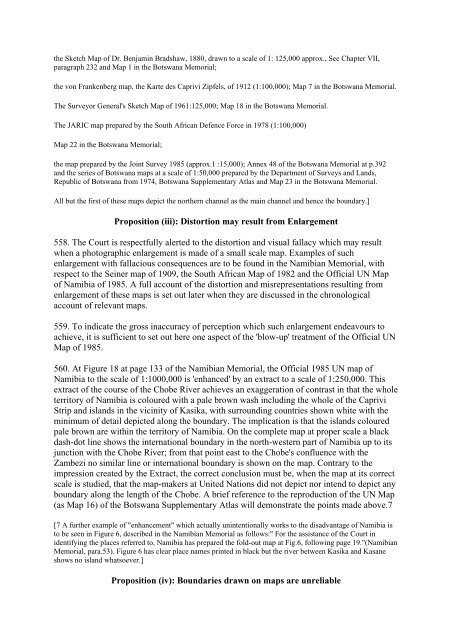botswana/namibia - Cour international de Justice
botswana/namibia - Cour international de Justice
botswana/namibia - Cour international de Justice
Create successful ePaper yourself
Turn your PDF publications into a flip-book with our unique Google optimized e-Paper software.
the Sketch Map of Dr. Benjamin Bradshaw, 1880, drawn to a scale of 1: 125,000 approx., See Chapter VII,<br />
paragraph 232 and Map 1 in the Botswana Memorial;<br />
the von Frankenberg map, the Karte <strong>de</strong>s Caprivi Zipfels, of 1912 (1:100,000); Map 7 in the Botswana Memorial.<br />
The Surveyor General's Sketch Map of 1961:125,000; Map 18 in the Botswana Memorial.<br />
The JARIC map prepared by the South African Defence Force in 1978 (1:100,000)<br />
Map 22 in the Botswana Memorial;<br />
the map prepared by the Joint Survey 1985 (approx.1 :15,000); Annex 48 of the Botswana Memorial at p.392<br />
and the series of Botswana maps at a scale of 1:50,000 prepared by the Department of Surveys and Lands,<br />
Republic of Botswana from 1974, Botswana Supplementary Atlas and Map 23 in the Botswana Memorial.<br />
All but the first of these maps <strong>de</strong>pict the northern channel as the main channel and hence the boundary.]<br />
Proposition (iii): Distortion may result from Enlargement<br />
558. The <strong>Cour</strong>t is respectfully alerted to the distortion and visual fallacy which may result<br />
when a photographic enlargement is ma<strong>de</strong> of a small scale map. Examples of such<br />
enlargement with fallacious consequences are to be found in the Namibian Memorial, with<br />
respect to the Seiner map of 1909, the South African Map of 1982 and the Official UN Map<br />
of Namibia of 1985. A full account of the distortion and misrepresentations resulting from<br />
enlargement of these maps is set out later when they are discussed in the chronological<br />
account of relevant maps.<br />
559. To indicate the gross inaccuracy of perception which such enlargement en<strong>de</strong>avours to<br />
achieve, it is sufficient to set out here one aspect of the 'blow-up' treatment of the Official UN<br />
Map of 1985.<br />
560. At Figure 18 at page 133 of the Namibian Memorial, the Official 1985 UN map of<br />
Namibia to the scale of 1:1000,000 is 'enhanced' by an extract to a scale of 1:250,000. This<br />
extract of the course of the Chobe River achieves an exaggeration of contrast in that the whole<br />
territory of Namibia is coloured with a pale brown wash including the whole of the Caprivi<br />
Strip and islands in the vicinity of Kasika, with surrounding countries shown white with the<br />
minimum of <strong>de</strong>tail <strong>de</strong>picted along the boundary. The implication is that the islands coloured<br />
pale brown are within the territory of Namibia. On the complete map at proper scale a black<br />
dash-dot line shows the <strong>international</strong> boundary in the north-western part of Namibia up to its<br />
junction with the Chobe River; from that point east to the Chobe's confluence with the<br />
Zambezi no similar line or <strong>international</strong> boundary is shown on the map. Contrary to the<br />
impression created by the Extract, the correct conclusion must be, when the map at its correct<br />
scale is studied, that the map-makers at United Nations did not <strong>de</strong>pict nor intend to <strong>de</strong>pict any<br />
boundary along the length of the Chobe. A brief reference to the reproduction of the UN Map<br />
(as Map 16) of the Botswana Supplementary Atlas will <strong>de</strong>monstrate the points ma<strong>de</strong> above.7<br />
[7 A further example of "enhancement" which actually unintentionally works to the disadvantage of Namibia is<br />
to be seen in Figure 6, <strong>de</strong>scribed in the Namibian Memorial as follows:" For the assistance of the <strong>Cour</strong>t in<br />
i<strong>de</strong>ntifying the places referred to, Namibia has prepared the fold-out map at Fig.6, following page 19."(Namibian<br />
Memorial, para.53). Figure 6 has clear place names printed in black but the river between Kasika and Kasane<br />
shows no island whatsoever.]<br />
Proposition (iv): Boundaries drawn on maps are unreliable

















